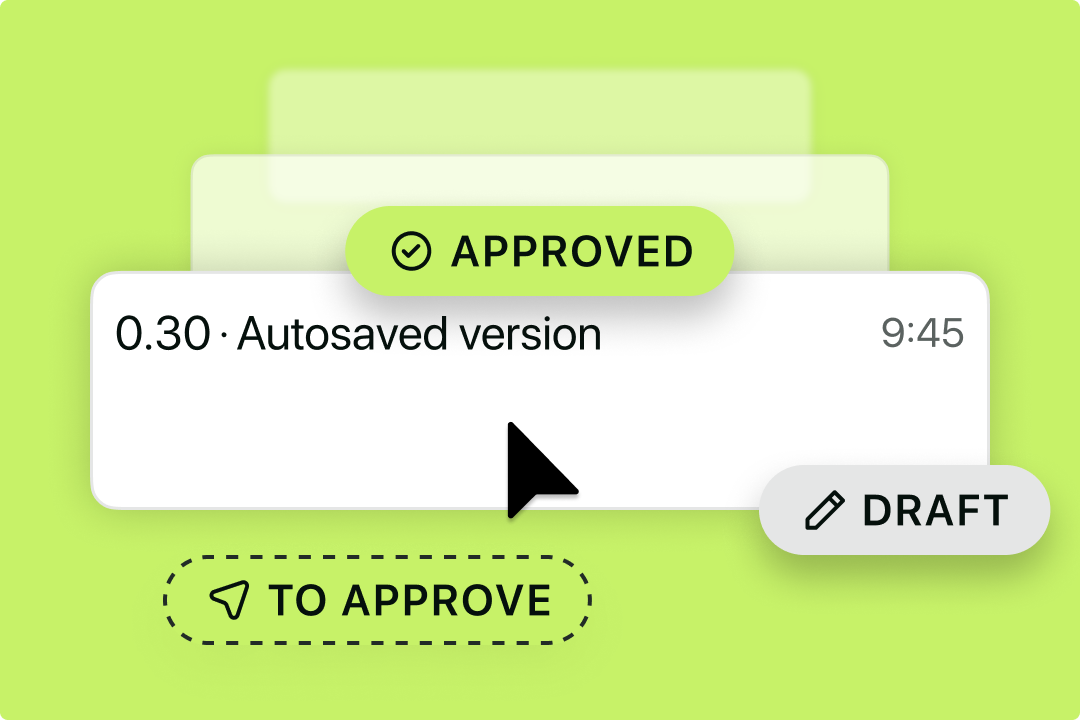Solutions
Customer Support
Resources
Using PDFs for contracts is better than using paper and ink - just. But how can you collaborate on PDF contracts with such a rigid file format? This guide to managing PDFs explains how to:
But most importantly of all, it discusses why this is still fundamentally a manual process, and what you can do to improve it through structured data and automation.
If you're finding the process of negotiating using PDF files painful, you can hit the button below to find out how businesses like yours are streamlining the negotiation process using Juro. Otherwise, keep reading.
Although PDFs are static documents, it is still possible to annotate them by adding comments and markups. However, it’s worth noting that Adobe’s commenting functionality is quite dated and restrictive, so it’s often preferable to review, amend and edit documents within a different platform, like Juro.
But if you do decide to add and respond to comments within a PDF, here’s how you can do it:
1. Open Adobe Acrobat and sign into your account.
2. Next, you’ll need to click ‘Edit’, which can be found in the navigation bar at the top of the screen. Then select the option that says ‘Add Comments’.

3. You’ll then be able to choose files from your documents list or drag and drop your chosen file. The PDF file will then be displayed on the screen with an ‘Add Comment’ toolbar above it.
4. Using this toolbar, you’ll be able to annotate and comment on PDF files in a variety of ways:
You can add a sticky note to the file by clicking on a particular area within the document

You can also add a text field comment by clicking and typing in the desired section of your PDF.

Or, you can add hand-written comments using the drawing tool. Although, this can be quite fiddly.

5. If you later choose to edit or delete these comments, you can select the comment and click ‘Edit’ from the options menu. From here you’ll be able to delete, undo or redo comments.

6. To download and share a version of the annotated PDF as a free user you’ll need to download the PDF and share it manually via email or another communication platform. Once you’ve done this, the recipient can open the PDF and review the comments added before responding to them in a separate version of the document.
Unlike software like Juro which was designed with contracts in mind, PDF editors fail to provide the advanced features that make negotiating and reviewing legal agreements seamless.
Although users can add comments to PDFs, these comments remain static and won’t be updated within a live document in real-time.
By comparison, Juro enables users to add internal comments to contracts in real-time, as well as adding external comments that are only visible to counterparties once you've committed to them. This functionality is perfect for negotiations!

Within Juro, users can also tag any part of a contract with comments, as well as tagging the relevant stakeholders to receive their input on these.
Parties can then discuss specific aspects of the contract in more detail using comment threads and approve these changes in real-time to move contracts along swiftly.
This isn’t possible using Adobe’s PDF editor, which can result in friction when managing contracts and other files that require a lot of back and forth.
The process of adding, reviewing, and actioning comments within a PDF is much more disjointed.
Even if users look beyond Adobe Acrobat’s dated interface, they’re often still confined to the administrative tasks traditionally associated with contract negotiations.
They’ll need to add comments to the PDF using a basic editor, download the revised version of the contract, send this to the relevant party via email, wait for a response and receive feedback within either the body of an email or in a separate, updated version of the PDF.
This process is incredibly manual and can involve multiple different tools. This can create growing pains for legal and business teams as their business scales and contract volumes grow.
It’s not possible to track changes in PDF documents in the same way that you can track changes in Microsoft Word files or using advanced redlining software.
Instead, revisions made to documents in a PDF will need to be saved as a separate document, which means creating and storing multiple copies of it. You’ll then need to compare the two versions of the PDF manually to track the changes made. Here's how to tracking changes in a PDF typically works:
1. Choose which two PDF files you want to compare with one another. Usually, you’ll want to select the most recent version of a document or contract prior to editing, and the since edited version.
2. You’ll then need to open Acrobat on your device, select ‘Tools’ and then click ‘Compare Files’ to access the PDF comparison tool.
.avif)
3. Click ‘Select File’ on the left of the screen and choose the older version of the PDF. Then click ‘Select File’ on the right-hand side of the screen and attach the newer version of the PDF.
4. Next, click the ‘Compare’ button, which will begin running the comparison.
5. From here, you can visualize the two PDF versions side by side to spot any edits manually by eye. Alternatively, you can click on ‘Results Summary’ which will present a summary of all of the changes, including what has been added, deleted, or changed within the PDF.
6. Go go through each individual edit one by one, you can click ‘Go to First Change’, which will allow you to review each of the changes made separately.
7. Once you’ve decided whether to accept or reject the changes made, you’ll need to make a copy of the PDF with your own revisions, which will then need to be sent over to the other party (usually via email) to be compared and reviewed once again.
This is a continuous process that will only end once all stakeholders are satisfied with the final version of the document or contract.
Since individual comments and changes will need to be made and reviewed in separate versions of a static PDF, the process requires a lot of repetitive admin.
This is an arduous process, particularly in the context of contracts where negotiations can extend for long periods of time and require a lot of deliberation.
In fact, if legal and business teams were to engage with PDFs and compare each round of changes in such a manual way, it would detract them from higher value work and result in lengthy delays getting contracts over the line.
One of the biggest pain points when comparing a PDF to track changes is that users need to move between tools continuously.
For instance, once a PDF version of a contract or document has been commented on, this will then need to be emailed over to the counterparty or department seeking to track the changes. It will then need to be saved and uploaded into Adobe Acrobat ready to compare.
Already, this short part of the review process can require up to four different platforms. Meanwhile, most document automation or contract automation software allows users to perform these processes in one workspace.
Another challenge of tracking changes made to PDFs is that it can become difficult to manage multiple versions of the same document. With different information and edits captured in different versions, important data can quickly get lost and the negotiation or editing process can become confusing.
If PDFs were replaced with a single, dynamic file, friction points could be detected early on from previous contracts in the form of contract data. These insights would result in a better-informed approach to negotiations and a faster turnaround time for contracts too.
It’s challenging, if not impossible, to capture this information from PDFs without trawling through endless versions of different contracts and capturing this data manually within a spreadsheet. Doing this for each and every contract you review the changes for is far from scaleable.
One of the biggest limitations of track changes in PDFs is that there’s no opportunity for parties to collaborate on documents in real-time, or even in the same file.
While individuals can add sticky notes and comments to a document to suggest changes, the process of reviewing and tracking these changes typically happens offline. This means there is no opportunity for them to discuss the changes in more detail, or provide counter-suggestions within the same document.
This makes internal review and negotiation painful in the context of contracts since it prevents parties from embracing a collaborative approach to negotiations and finding mutually beneficial solutions quickly and efficiently.
While it is possible to add redlines to a PDF contract, the Adobe platform doesn’t provide the advanced features offered by some contract redlining software solutions. Here's how you can redline PDF contracts, though:
1. Open Adobe Acrobat and select the file you want to add redlines to. Once you’ve selected the file, click ‘Open’. You’ll also need to log in to your account if you have one.
2. Once you’ve opened the PDF, click ‘View’, followed by ‘Toolbars’, and ‘Comment & Markup’. This will bring up a floating toolbar with some basic editing functionality to help you annotate the document. This will allow you to highlight, strikethrough, underline and copy text contained within the PDF.

3. If you want to remove a certain clause from the contract, you can strike through it, or add a red line using the line commenting tool and changing the colour to red.
4. If you want to suggest changes to a particular clause rather than deleting it, you can highlight it and add a comment beside it with your recommendations. This can be done by adding a sticky note to the document in the editor.
5. After you’ve added your suggested edits to the contract draft, you can download the finished document ready to share with your counterparty.
Since there’s not a separate sidebar in Adobe Acrobat to clearly display individual suggestions and redlines, PDFs that are littered with annotations and strikethroughs can quickly become messy. This is similar to the traditional method of contract redlining, where contracts were annotated with a red pen.
By comparison, when a contract is redlined using a contract automation platform like Juro, all of the redlines appear neatly at the side of the contract as suggestions, linking to the relevant part of the clause. This makes it easier for counterparties to identify exactly what’s being proposed and how it would change the contract’s existing wording.
There’s also the problem that, in order to accept and action the redlines added to a PDF, the counterparty will need to manually update the contract draft with the redlines they approve. This usually happens by creating a separate copy of the original, redlined contract.
Accepting and rejecting in a contract tool like Juro is far easier as each redline has an ‘Accept’ or ‘Reject’ button. Depending on what you decide, the changes are made to the contract automatically and in real-time. You can also click ‘Resolve’ if the comment has been discussed offline.
This reduces contract admin that would otherwise have been required when redlining and accepting redlines in PDFs. This can save legal and business teams a significant amount of time as the manual process would need to be repeated continuously until both parties have agreed on a set of terms.
Fortunately, we are now in an age where contracts no longer need to exist as static PDFs, and businesses no longer need to use the makeshift features contained within PDF editors to comment on, redline, and track changes within contracts.
Instead, legal teams and those they enable can create dynamic contracts in software designed to advance collaboration, not restrict it. Juro is a prime example of this. When using Juro to create and manage contracts, users can:
Rather than creating and annotating a new version of a contract every time you want to suggest changes, Juro allows users to add suggestions to the contract in-browser.
Users can suggest changes and add redlines within a few clicks, and these can then be pushed forward to the relevant party for their approval.
Approving or rejecting these suggestions also won’t require creating a whole new version of the contract, as suggestions can be either accepted or rejected in just a few clicks. This also provides transparency around which suggestions have been rejected, which can prove useful in future negotiations.

In Juro, users can add internal comments for their colleagues to view and respond to, as well as external comments for negotiations with counterparties. Users can tag specific parts of the contract with comments and even discuss specific clauses in more detail using threaded comments.
Looking to get the attention of a particular stakeholder and speed up the contract process? Juro allows users to mention relevant parties within comments on the contract to receive their feedback on certain elements of the contract.
This makes it easy to get the right stakeholders involved in contracts at the right time and move contracts through the workflow faster.
Juro users can even control which contract terms are non-negotiable by turning off comments and suggestions for certain parts of the contract.
This functionality is great for managing standard contracts like NDAs whereby the terms are set in stone and gives legal teams greater control over contracts without needing their constant oversight.
Juro users can also create their templates so that only smartfields can be edited, not free text.

Unlike PDF editors which only enable users to add comments to PDF contracts and approve these by creating (and agreeing) a new version of the contract with the updated terms, Juro can ensure changes to a contract are approved quickly and securely.
This is achieved through Juro’s contract approval workflows. This feature enables users to request approval from the relevant stakeholders (e.g finance and legal) on a contract’s terms and automatically add approvers to contracts that user certain templates.
Within Juro, contract approvers can be set up in a sequence or without. However, a contract will only be able to progress once this approval has been received, improving visibility and security over high-value business contracts in turn.
Instead of needing to manually compare the specific changes between two versions of the PDF contract, Juro allows users to have greater visibility over contract edits and suggestions using a timeline of changes.
Using this, parties can quickly review different versions of the contract as it progresses through the stages of the contract lifecycle.
This ensures that changes can be tracked quickly and with minimal administrative input.
Juro makes it significantly easier to maintain version control when negotiating and updating contracts - something PDF contracts and contracts in Word typically fail at.
In a traditional workflow (without Juro), there will typically be multiple versions of the same contract sent back and forth via email, each with different edits and recommendations.
These suggested changes and edits are difficult to collate, and it knowing which version of a contract is most up to date can become a challenge.
But in Juro, users can quickly manage version control and reflect on previous edits within the platform.
Since contracts created in Juro are live and dynamic, updating contracts doesn’t mean creating parallel versions. Instead, users can use Juro’s audit trail functionality to track changes without moving between different files and platforms.
If the reason you’re trying to comment on, redline, and track changes within a PDF is because the contract needs to be finalized in a PDF format, don’t stress.
Juro has an option for users to save contracts in a PDF format at any stage with just one click. You can even upload PDF files directly into Juro, where they can be signed, tagged, and stored for future use.
It’s no secret that managing contracts as PDFs can create a lot of friction. It’s hard to comment on a PDF, tedious to redline one, and near impossible to track the changes you make. Juro removes this friction, enabling you to process contracts end-to-end in one, flexible, and easy-to-use platform.
If you’re looking to reduce contract admin and scale your contract workflow without losing control of contracts, why not join the 6000+ companies powering contracts with Juro?
Keen to find out more? Fill in the form below.
Lorem ipsum dolor sit amet, consectetur adipiscing elit. Suspendisse varius enim in eros elementum tristique. Duis cursus, mi quis viverra ornare, eros dolor interdum nulla, ut commodo diam libero vitae erat. Aenean faucibus nibh et justo cursus id rutrum lorem imperdiet. Nunc ut sem vitae risus tristique posuere.

